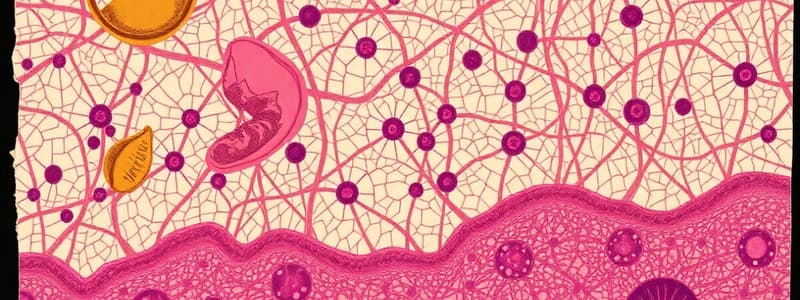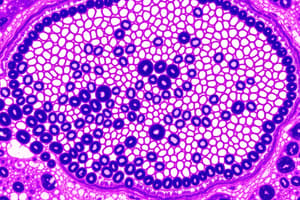Podcast
Questions and Answers
Which characteristic is LEAST useful when classifying epithelial tissue?
Which characteristic is LEAST useful when classifying epithelial tissue?
- Cell shape
- Cell arrangement
- Function of the tissue (correct)
- Number of cell layers
A tissue sample shows multiple layers of cells with the most superficial layer being flattened and scale-like. Which type of epithelium is this?
A tissue sample shows multiple layers of cells with the most superficial layer being flattened and scale-like. Which type of epithelium is this?
- Stratified cuboidal
- Simple squamous
- Transitional
- Stratified squamous (correct)
In which location would you expect to find pseudostratified columnar epithelium?
In which location would you expect to find pseudostratified columnar epithelium?
- Lining of blood vessels
- Lining of the stomach
- Lining of the trachea (correct)
- Epidermis of the skin
Which type of epithelium is specialized to stretch and is found in the lining of the urinary bladder?
Which type of epithelium is specialized to stretch and is found in the lining of the urinary bladder?
Which of the following is a critical distinction between endocrine and exocrine glands?
Which of the following is a critical distinction between endocrine and exocrine glands?
A gland releases its secretion by rupturing the entire cell. Which type of secretion is this?
A gland releases its secretion by rupturing the entire cell. Which type of secretion is this?
Which of the following properties is shared by ALL types of epithelium?
Which of the following properties is shared by ALL types of epithelium?
What is the PRIMARY function of the basal lamina found underlying epithelial tissues?
What is the PRIMARY function of the basal lamina found underlying epithelial tissues?
Which type of cancer originates from glandular epithelial cells?
Which type of cancer originates from glandular epithelial cells?
What is the role of intercellular junctions (junctional complexes) in epithelial tissue?
What is the role of intercellular junctions (junctional complexes) in epithelial tissue?
Which characteristic primarily distinguishes pseudostratified columnar epithelium from stratified columnar epithelium?
Which characteristic primarily distinguishes pseudostratified columnar epithelium from stratified columnar epithelium?
How does the transitional epithelium of the urinary bladder accommodate volume changes?
How does the transitional epithelium of the urinary bladder accommodate volume changes?
Which of the following best describes the functional distinction between microvilli and stereocilia found on epithelial cells?
Which of the following best describes the functional distinction between microvilli and stereocilia found on epithelial cells?
What is the primary difference in secretion mechanism between merocrine and holocrine glands?
What is the primary difference in secretion mechanism between merocrine and holocrine glands?
How do mucous glands differ structurally from serous glands in the epithelium?
How do mucous glands differ structurally from serous glands in the epithelium?
Which modification to epithelial cells is most directly related to facilitated diffusion?
Which modification to epithelial cells is most directly related to facilitated diffusion?
What is the functional significance of myoepithelial cells found in association with certain exocrine glands?
What is the functional significance of myoepithelial cells found in association with certain exocrine glands?
How does the distribution of simple squamous epithelium contribute to its function in the alveoli of the lungs?
How does the distribution of simple squamous epithelium contribute to its function in the alveoli of the lungs?
What is a key structural adaptation of goblet cells that supports their function of mucus secretion?
What is a key structural adaptation of goblet cells that supports their function of mucus secretion?
What is the major role of epithelial cell junctions in maintaining tissue integrity and function?
What is the major role of epithelial cell junctions in maintaining tissue integrity and function?
Flashcards
Epithelial Tissue
Epithelial Tissue
Avascular tissue that covers body surfaces and lines cavities.
Cell Characteristics
Cell Characteristics
Epithelial cells are arranged in sheets with distinct surface domains: apical, lateral, and basal.
Types of Epithelium
Types of Epithelium
Classified by cell arrangement (simple or stratified) and shape (squamous, cuboidal, columnar).
Simple Squamous Epithelium
Simple Squamous Epithelium
Signup and view all the flashcards
Cuboidal Epithelium
Cuboidal Epithelium
Signup and view all the flashcards
Columnar Epithelium
Columnar Epithelium
Signup and view all the flashcards
Pseudostratified Epithelium
Pseudostratified Epithelium
Signup and view all the flashcards
Transitional Epithelium
Transitional Epithelium
Signup and view all the flashcards
Exocrine Glands
Exocrine Glands
Signup and view all the flashcards
Endocrine Glands
Endocrine Glands
Signup and view all the flashcards
Epithelial Characteristics
Epithelial Characteristics
Signup and view all the flashcards
Glandular Epithelium
Glandular Epithelium
Signup and view all the flashcards
Mucous Glands
Mucous Glands
Signup and view all the flashcards
Serous Glands
Serous Glands
Signup and view all the flashcards
Exocrine Secretion Modes
Exocrine Secretion Modes
Signup and view all the flashcards
Merocrine Secretion
Merocrine Secretion
Signup and view all the flashcards
Apocrine Secretion
Apocrine Secretion
Signup and view all the flashcards
Holocrine Secretion
Holocrine Secretion
Signup and view all the flashcards
Comparative Functions of Epithelium
Comparative Functions of Epithelium
Signup and view all the flashcards
Study Notes
Epithelial Tissue
-
Characteristics: Epithelial tissues are arranged in sheets, possessing intercellular junctions. They have distinct apical (free), lateral, and basal surfaces, with properties determined by membrane proteins. They rest on a non-cellular basal lamina, a protein-polysaccharide layer.
-
Avascular: Lacking blood vessels.
-
Locations: Cover body surfaces, line internal cavities (closed), form glands and ducts, and make up sensory receptors.
-
Functions: Transport (via cilia moving mucus), sensory reception (neuroepithelia like taste buds), lubrication (mucus or serous fluid), excretion (filtering blood, producing urine/sweat), and reproduction (in ovaries/testes).
Epithelial Classification
-
Based on cell arrangement: Simple (single layer) or stratified (multiple layers).
-
Based on cell shape: Squamous (width > height), cuboidal (width, height, depth similar), columnar (height > width), low columnar (height slightly exceeds width), pseudostratified (appears stratified but all cells rest on the basal membrane)
Specific Epithelial Types
-
Simple Squamous: One layer, flat cells. Found lining blood vessels, Bowman's capsule, respiratory spaces. Function: exchange, barrier.
-
Simple Cuboidal: One layer, cube-shaped cells. Located in thyroid follicle walls, kidney tubules, ovary surface, small gland ducts. Function: secretion, absorption.
-
Simple Columnar: One layer, tall, column shaped. Lines the intestines, uterus, gall bladder. Function: absorption, secretion, barrier.
-
Stratified Squamous: Multiple layers, squamous cells on surface; functions as a barrier. Keratinized (skin) or non-keratinized (lining of oral cavity/vagina).
-
Pseudostratified Columnar: Appears layered but all cells rest on the basement membrane. Found in the respiratory tract (ciliated), epididymis, and ductus deferens
-
Transitional Epithelium: Stratified epithelium that can stretch (distension). Located in the urinary bladder, parts of the urethra, and ureters (renal calyces).
Glands
-
Definition: Masses of epithelial cells adapted for secretion.
-
Types:
- Exocrine: Secrete substances onto epithelial surfaces via ducts. Unicellular (goblet cells) or multicellular.
- Endocrine: Secrete hormones into the bloodstream.
Exocrine Gland Structure & Secretion
-
Multicellular exocrine glands are categorized by: duct type (simple or compound), shape of the secretory unit (acinar/alveolar or tubular), and secretion mode.
-
Modes of secretion:
- Merocrine: Most common, products released by exocytosis (e.g., salivary glands).
- Apocrine: Portions of the gland's cells are lost with the secreted product (e.g., some sweat glands).
- Holocrine: Entire cells rupture and release the product (e.g., sebaceous glands).
Epithelial Regeneration and Pathology
-
Regeneration: Epithelia (like epidermis and intestines) have high renewal rates.
-
Carcinoma: Cancer of epithelial origin.
-
Adenocarcinoma: Cancer of glandular epithelium.
-
Sarcomas: Cancers of mesenchymal origin.
Studying That Suits You
Use AI to generate personalized quizzes and flashcards to suit your learning preferences.
Description
Explore epithelial tissue: its arrangement in sheets with specialized surfaces, avascular nature, and locations covering body surfaces and forming glands. Learn about its diverse functions, including transport, sensory reception, lubrication, excretion, and reproduction. Understand classification based on cell arrangement and shape.



